Minimal Travel Table Top Game Collection 2: Social Distancing Edition
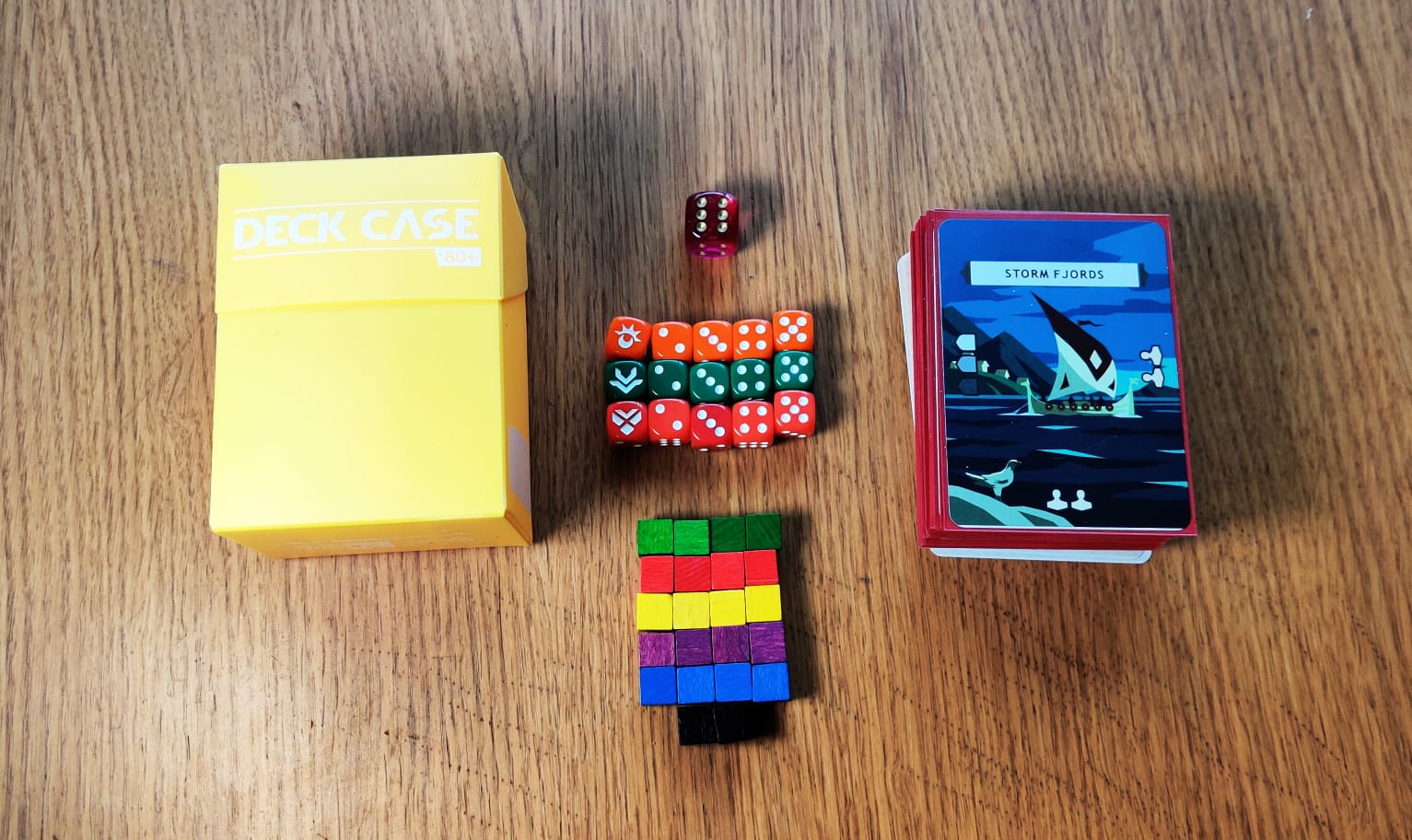
During my Christmas holiday, I created Minimal Travel Table Top Game Collection. The idea was to build a box with a set of games based on cards and dice that I could fit into my backpack to carry with me on my day-to-day life and travels. Then things happened and traveling and playing board games become a bit more difficult.
So, one weekend being alone at home, I started to look back into the Print and Play game design community and especially games that are meant for a single player. And to stay true to the Minimal Travel theme, I wanted small games.
Lucky for me, BoardGameGeek hosts plethora of different table top game design contests and one of them is an annual 9 Card Game Print and Play Design Contest where game designers and hobbyists come together to build interesting new games. Let's take a look at what I ended up with.
The Contents
I started my box from the same premise as with my first MTTTGC: an Ultimate Guard 80+ Deck Box. I have these laying around and I think they are a great size for small card & dice game collections. They are small enough to challenge you to make difficult choices but fit so nicely into your pocket or backpack.
Last time all of my games were fitted to be single-sided so I used Dragon Shield's Red Matte sleeves. This time I wanted to try something new, so 60% of my games are still using these sleeves and are required to flip over when switching games. But I also wanted to experiment (and 18 card faces compared to 9 opens up so many possibilities for game mechanics and replayability) so two games are double-sided and use Arcane TinMan's clear board game sleeves (although in pictures below, I didn't yet have those sleeves).
As many of these games use bit more additional pieces than just cards, I decided to go with 45 cards (5 sets of 9) and ended up with 8 games. I also have cubes and meeples in 6 colors (5 x 6 cubes, 5 x 2 meeples) + one smaller set of 2 cubes and meeples in black.
The Games
This time the pool of possible games was quite a lot more limited than last time. Solo games are much smaller niche than multiplayer games and while there are multiplayer games that can be played alone, I wanted to find games that are designed solo play first.
Switchboard
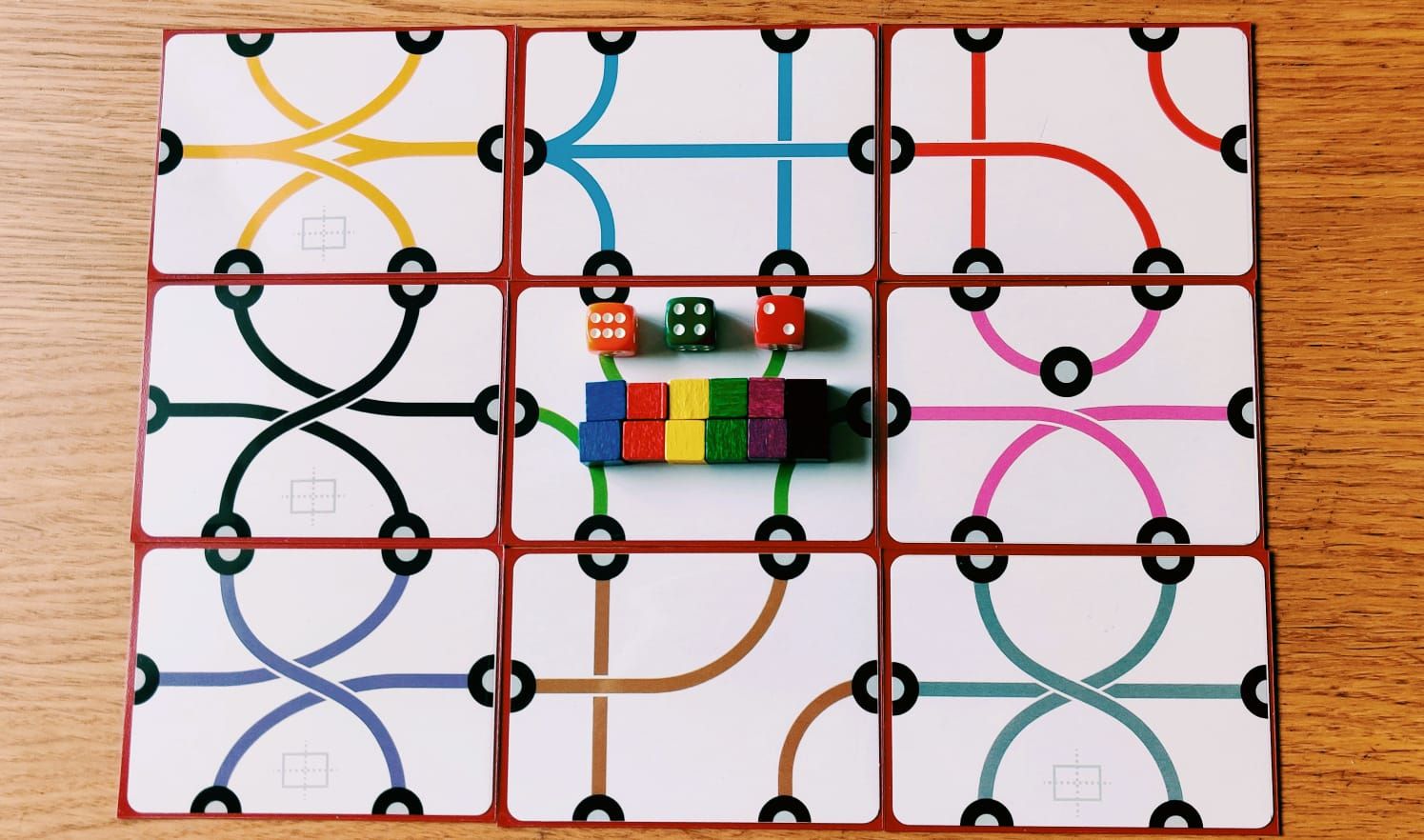
My first game of the set is Switchboard - A Solo Game of Crossed Lines which is a puzzle game designed by Mark Tuck for 2019 design contest where it finished 3rd in both the solo game and the overall category. It uses 9 single-side cards 12 cubes of 6 different colors and 3 D6 dice.
This game is a puzzle game with nice amount of randomness which means it will provide a great replay value, which is more important in solo games than multiplayer games which can gain a lot of replay value from other people.
You play as a telephone switchboard operator (I have to say, I've grown fond of this theme as I also enjoy Switchboard Operator game from 2018 Global Game Jam) who needs to connect a growing number of calls by swapping or rotating cards (that represent phone lines) or moving recipients around the edges. The game uses dice as a marker for both timer and scoring. Each operation costs valuable seconds and if you cannot connect all calls in round before you run out of time, you lose.
Mini Rogue
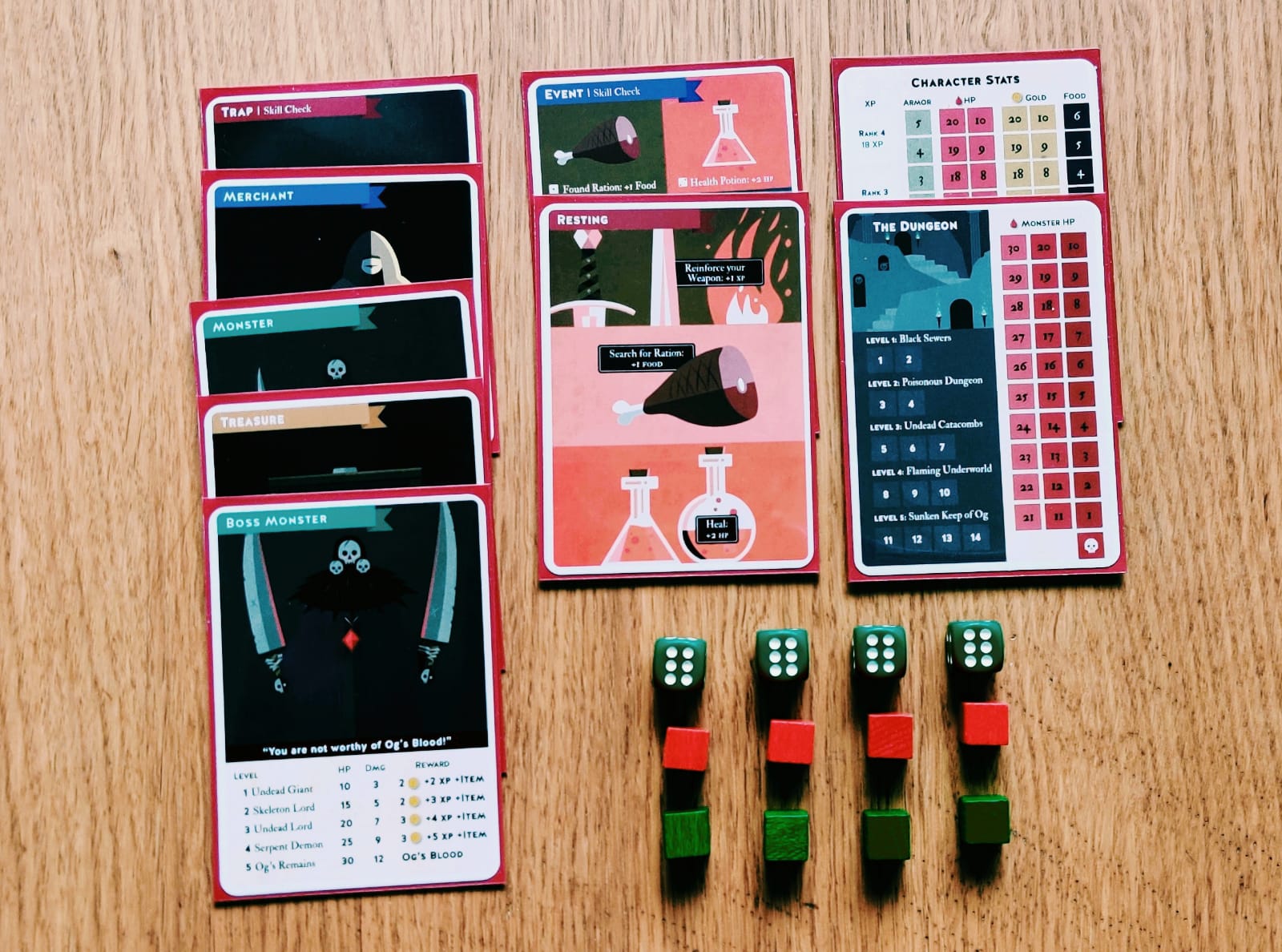
Mini Rogue by Paolo Di Stefano and Gabriel Gendron is a representative of its category in this set. Turns out, building different kind of light role-playing games and dungeon crawlers is a very popular thing in this PnP Micro Solo Game world. I took a look at a dozen of them and decided to go with Mini Rogue.
It finished 2nd place in both solo game and overall game categories in 2016 9-Card Nanogame Design Contest and was a nominee for 2016 Golden Geek Best Print & Play Board Game awards and based on reviews and discussions, seemed to be the best of its kind in the dungeon crawler category.
Played with 9 single-side cards, 4 D6 and 8 tokens, Mini Rogue sends you fighting monsters in dungeons. It packs four different difficulty levels, branching dungeons, RPG stats with leveling up and boss fights into a very small package and is a delight to play.
One of the reasons I chose this game was how extensive they were able to make it with so few elements. Each card provides different challenges and rewards depending on the level of dungeon you are in and even though there's not unlimited amount of randomness, different randomized dungeon layouts provide different type of adventures.
Another game I considered at the end was 8-bit Dungeon by Robert Lausevic that is part of currently on-going 2020 9 Card Game Print and Play Design Contest. Maybe I'll revisit that one after the contest is over.
Forest Guardians
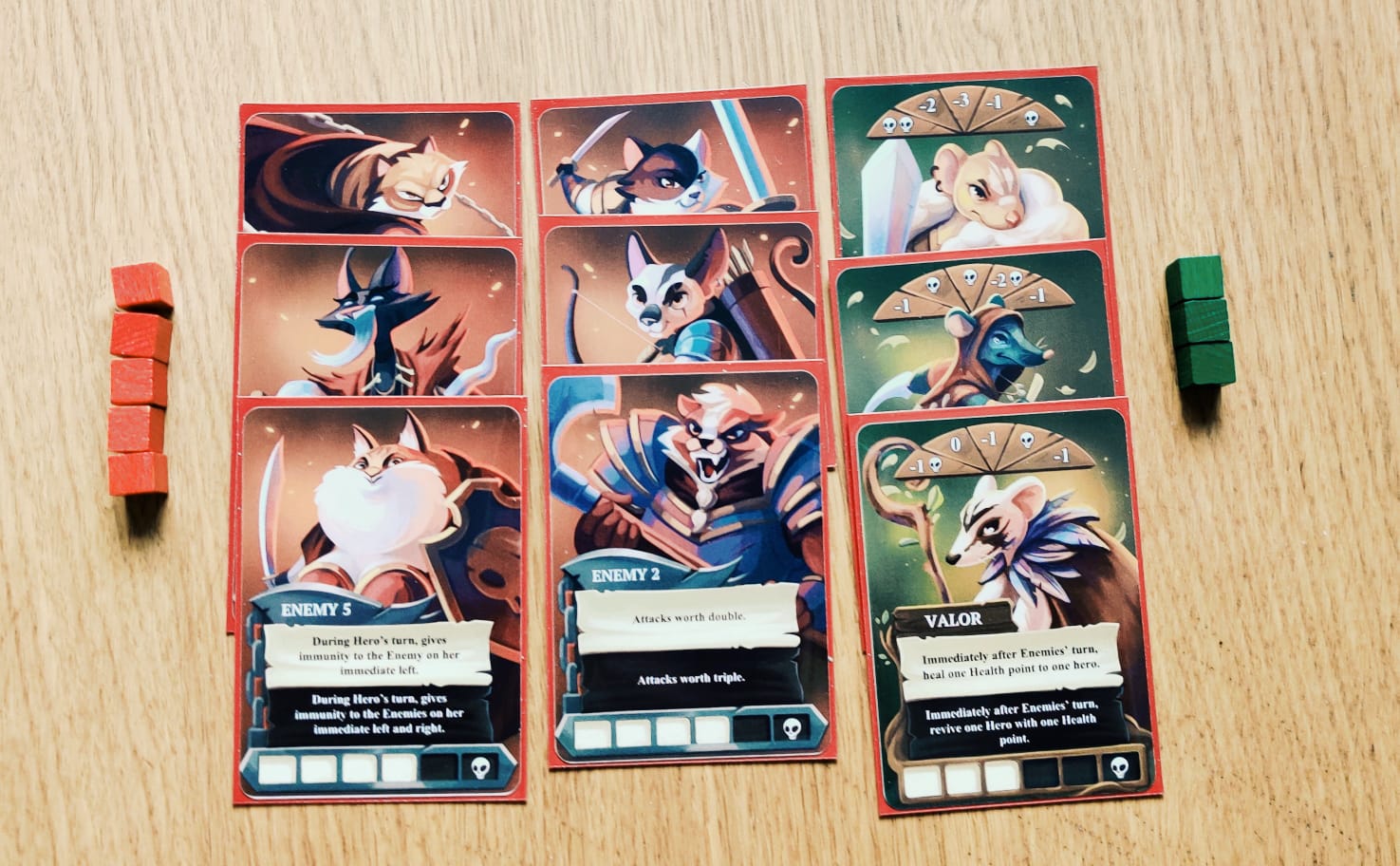
Just look at those cute characters! Forest Guardians is a new game by Bunyol De Vent and is currently competing in the 2020 9 Card Game Print and Play Design Contest. It features incredible art and is played with 9 single-side cards and 8 cubes.
You are playing as three heroic mice who fight against evil cat knights in a very interestingly designed game that uses positions and level of health in a refreshing way. Each turn, you select one of your heroes to fight and attacks and damage are based on the positioning of enemies. Special abilities change as characters take damage and they for example move characters around.
So far, I'm not sure how much replay value this game offers in the long run. It might turn out that there won't be enough interesting combinations that will emerge from 6 enemies and 3 heroes but only time will tell that.
12 Patrols
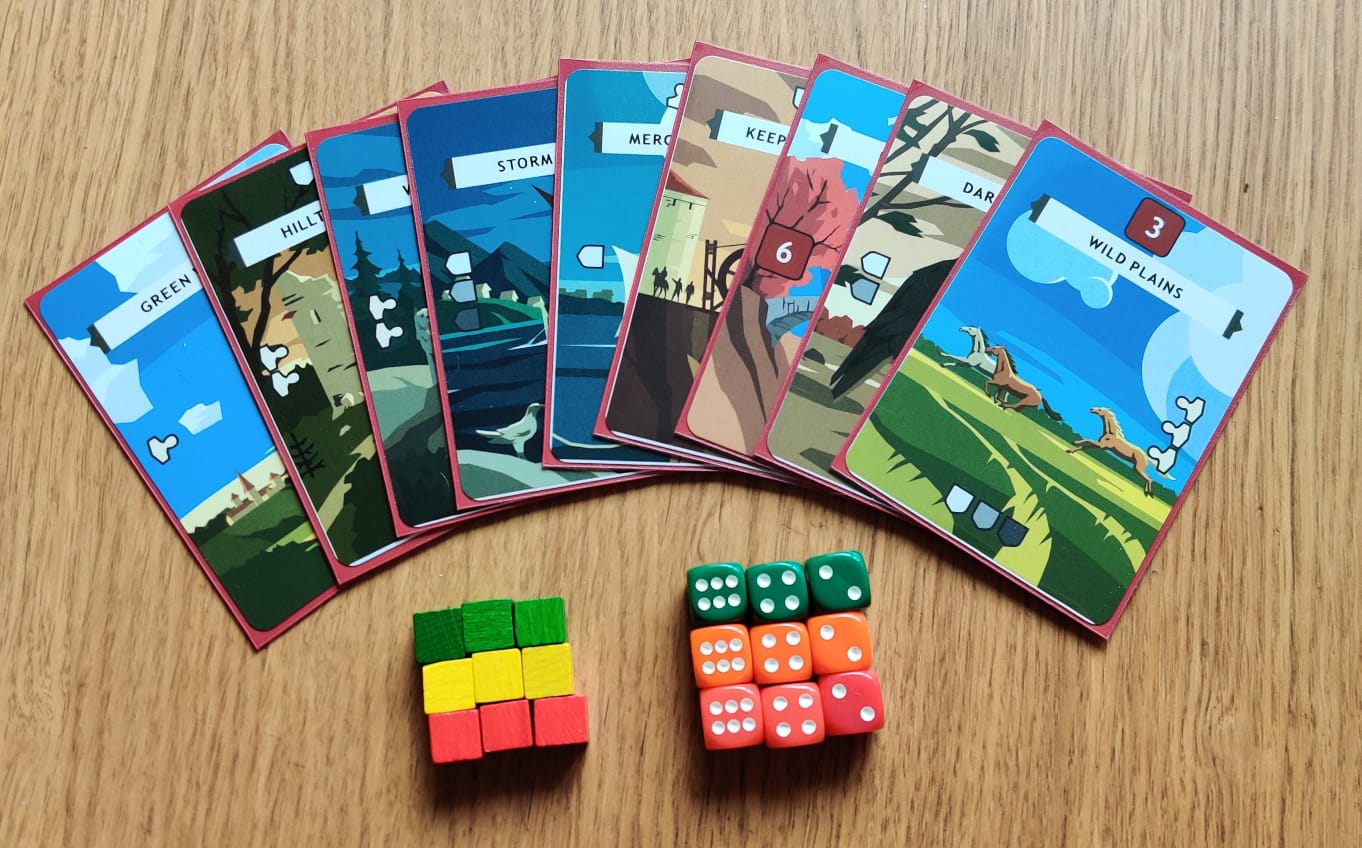
The next game on the list, 12 Patrols by Scott Allen Czysz, is a game I expect spending longest with from the games in this set. It offers interesting challenges in a lightweight puzzle type of set matching game. Played with 9 cards (+ 3 if you print the expansion), 9 D6 and 9 cubes, every game is a different one with plenty of randomization through cards and dice rolls.
In 12 Patrols, you're tasked with protecting the kingdom by placing 12 patrols of knights and soldiers around a 3 x 3 grid. The catch is, each card has requirements that must be met. For example, Wolven Forest requires you to have exactly 2 knights or soldiers to the north of it in the entire column. As you place the cards and patrols as you build the randomized kingdom, you have to be careful to not block your future moves by adding the wrong amount of patrols.
There are three type of requirements: sum of dice, amount of patrollers and the type combination of patrollers and they are all solved for the entire row or column. Not the type of puzzle I'm usually very good at and that was exactly the reason I picked this game. The artwork is also beautiful and nicely thematic. I will probably print the extension cards as well in the future to further expand the possible kingdoms but had to drop it from this one to fit the 45 card limit. If you're thinking about this game, go for the full 12 from the beginning.
9 Card Siege
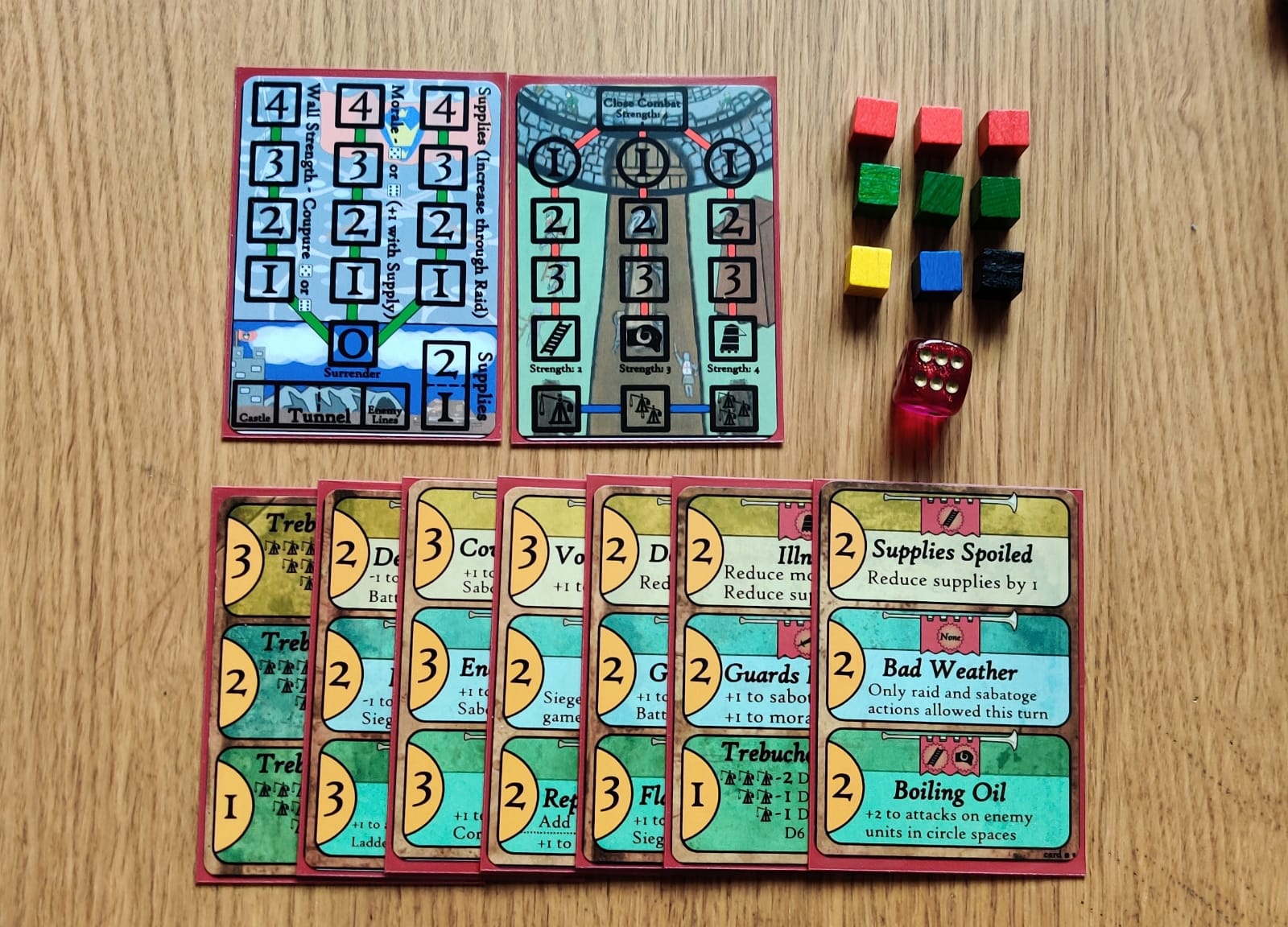
9 Card Siege by Chris Hansen was developed for the 2017 9-Card Nanogame Print and Play Design Contest where it finished 2nd in the wargame category. It uses 9 single-side cards, 9 cubes and 1 D6 to build an experience of defending a medieval fortress that's under siege. I originally found the game through recommendations on the forum.
The game throws you into the middle of an intensive battle where you have to survive for 3 days fending off enemy attacks. Each day is divided into 7 turns and consists of advancing the enemy, playing cards and taking actions.
At this point, I haven't played a lot of 9 Card Siege yet so it's hard to give a fair review of the game. I have played a bit of Castle Panic before and I'm eager to see how the format fits into a smaller game.
Zone Runners
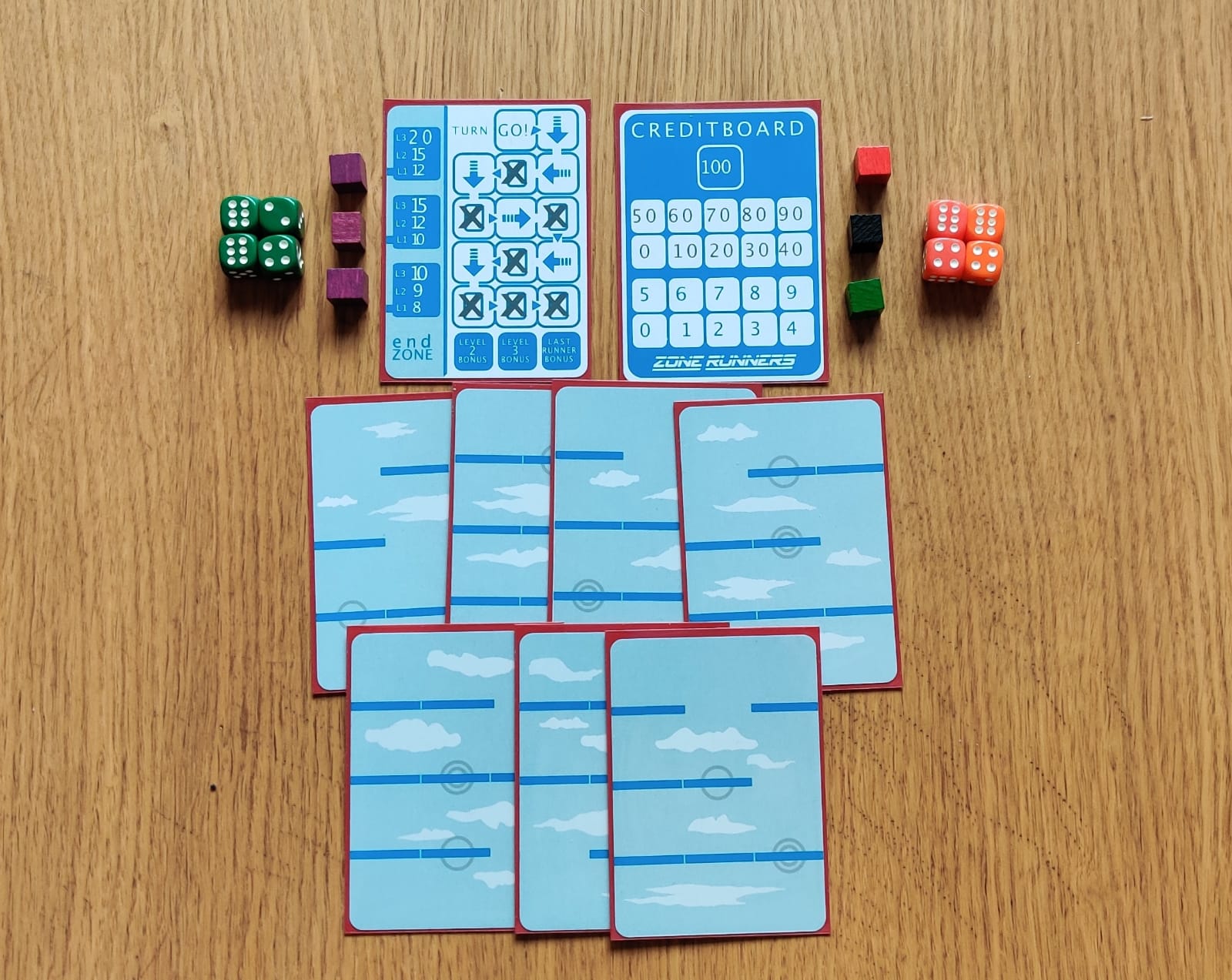
(I failed at printing these cards and the fonts in some of them got messed up so please notice that the original art is much better than my printed ones in the picture.)
I have to admit, I was bit struggling to fit the last single-sided spot. Many games use double-sided cards or just felt a bit off or unfinished to my taste. I ended up going with Zone Runners from 2017 9-card Nanogame PnP Design Contest where it won the solo category and finished 2nd in the overall category.
Designed by Mark Tuck (who also designed the Switchboard above), Zone Runners uses 9 single-side cards, 8 D6 and 9 cubes of 4 colors. It puts you into a TV game show from the future where contestants run in an obstacle course dodging mutants and avoiding gaps.
Your team of three runners have different abilities and based on the roll of dice, you assign them to runners in a way that helps your team overcome the challenges of the course and reach the end with maximum amount of credits.
Empire
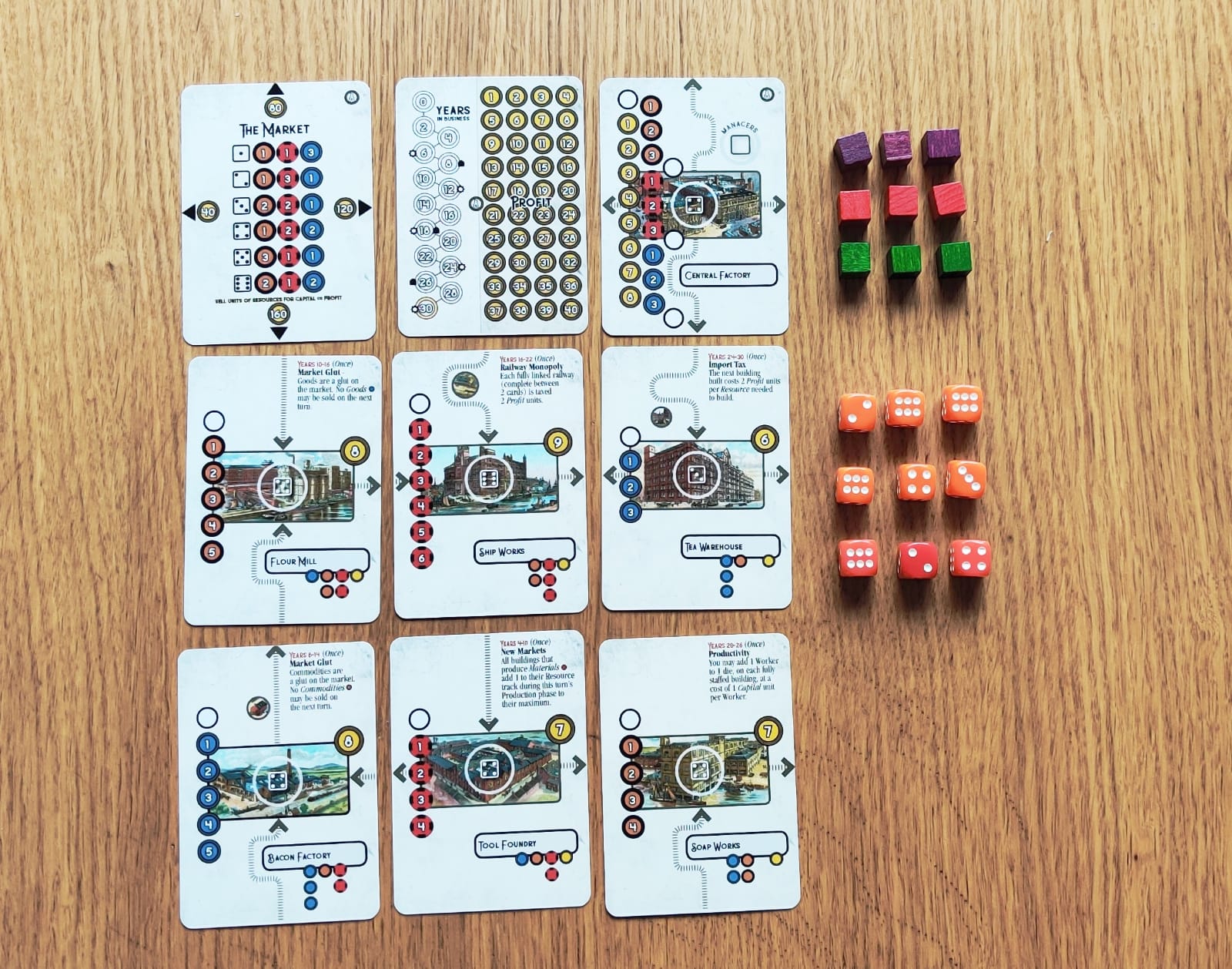
Todd Sanders' Empire is a 2019 9 Card Game Print and Play Design Contest game that finished 7th in the solo and 9th in the overall category. It's the first game in this list to use double-sided cards and adds to it 9 D6 and 9 cubes to build a game where you'll build an industrial empire by building factories, hiring workers and selling the goods to the market over a 30-year period of time.
I wanted to add a couple of games with bit more complex game play and rules to see how far the 9 card limitation could be taken. Empire was the first of these two and as a big fan of resource management games, I wanted to add it to the collection.
For each turn, you roll a die to set the market values, build buildings from randomly available selection, hire workers and produce goods. The game has simple and easy-to-learn mechanics but offers nice depth in the strategic decisions. The randomness of buildings available and market values at different times increases the replay value a lot as you cannot just rely on one single sequence of actions from one game to another to maximize your profit.
So if you're looking to build big industrial empire in small form factor, I recommend taking a look at Empire. If you have friends around and are more interested in larger games, I highly recommend East India Company which requires players to be tabletop-savvy but offers great depth in building a profitable business together while making sure you're the individual who benefits most.
Count of Nine

Last but not least in this box, I have Count of Nine by Scott Allen Czysz (who also made 12 Patrols in this box). It finished 2nd place in both solo and overall game categories in 2019 9 Card Game Print and Play Design Contest.
Count of Nine is a euro-style city building game played with 9 double-sided cards. Each card represents 1 or 2 buildings that can be built as well as resources that it provides. At any point, you'll have an opportunity to build one of the buildings shown in the face-up cards (2-3 options at a time) and each card will only be available for a few turns per round. The game is scored by most victory points (minus rounds played) in 2 games.
It's an interesting game that forces you to make continuous decisions based on very limited resources. I feel like its sometimes bit too restricted and luck-based and you might really brick with the order of the cards you draw. The limitations are crucial for any resource management game but the way this game gets rid of your options on a quick rotation feels bit too volatile.
Conclusions
It's been an interesting journey researching the world of solo micro/nano games. I'm excited to see how many different type of games people have been able to make within these restrictions. And it's been fun to read through the discussions of these games being developed and gaining incredible insights into the process of tweaking and balancing games based on game testing. And of course seeing how supportive the table top gaming community is.
I actually noticed only when writing this blog post that I ended up with two games by same designers. Mark Tuck's Switchboard and Zone Runners and Scott Allen Czysz's Count of Nine and 12 Patrols made the list but looking back, it's not a big surprise. Going down the funnel of table top design to print and play to 9 cards to solo games to top games shrinks the amount of designers quite small.
There's one game that didn't make the cut but that I really want to play. Under Falling Skies by Tomáš Uhlíř pretty much swept the table in 2019 9 Card Game Print and Play Design Contest winning 5 categories and finishing 2nd in 3. Expanding on the base mechanic of video game classic Space Invaders, Under Falling Skies provides an interesting scifi card game that I'll have to add to the mix if I get bored with one of these in the list.
The quality of cards this time was much worse than in my first collection (totally my fault, not original designers or manufacturer). In the first collection, I recreated all cards from scratch which guaranteed a continuing artwork beyond bleed lines. This time, I took existing cards (on A4 PDFs) meant for print-and-cut and those did not include any bleeds. I tried my best to stretch the card images as far as I could but as a lot of them have crucial game play information on sides, this ended up with some white lines on some sides of some cards.
For a single player collection, that doesn't really matter but for the future builds, I'll take this into more consideration and spend more time recreating the artwork and copying the game mechanics to guarantee the cards look as slick as the gameplay is smooth.
If something above resonated with you, let's start a discussion about it! Email me at juhamattisantala at gmail dot com and share your thoughts. In 2025, I want to have more deeper discussions with people from around the world and I'd love if you'd be part of that.